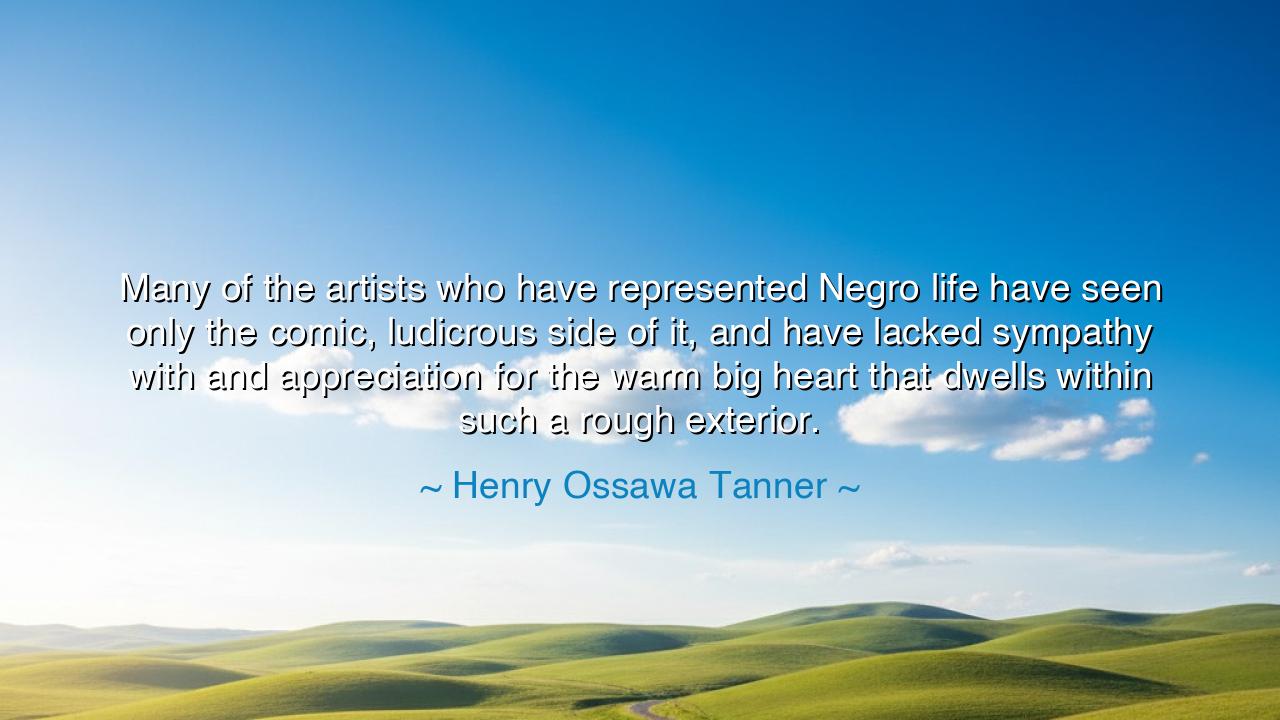
Many of the artists who have represented Negro life have seen
Many of the artists who have represented Negro life have seen only the comic, ludicrous side of it, and have lacked sympathy with and appreciation for the warm big heart that dwells within such a rough exterior.






Hear the voice of Henry Ossawa Tanner, master painter and visionary of spirit, who declared: “Many of the artists who have represented Negro life have seen only the comic, ludicrous side of it, and have lacked sympathy with and appreciation for the warm big heart that dwells within such a rough exterior.” These words, born of both pain and truth, strike like a bell through the corridors of history. For Tanner knew that art was more than entertainment; it was a mirror of humanity. And too often, in his age, that mirror was warped, showing caricature where there should have been dignity, ridicule where there should have been reverence.
The meaning of this saying lies in the failure of artists who, blinded by prejudice or ignorance, reduced the life of Black men and women to jest and mockery. They painted and performed the comic, ludicrous side, ignoring the depths of humanity, the struggles, the loves, the triumphs, the sorrows. Tanner calls this failure not merely artistic, but moral, for it is rooted in a lack of sympathy—the inability, or unwillingness, to see with compassion and respect the true essence of a people. Against this, he lifts the truth: that beneath any roughness imposed by hardship or poverty dwells a warm, big heart, rich with love, endurance, and spirit.
Tanner himself was the son of a former slave turned bishop. He knew both the roughness of the world and the depth of human resilience. His own art sought to reveal the sacred dignity of Black life and of human life itself. In works like The Banjo Lesson, he replaced the stereotype of the minstrel with a tender image of generational teaching, a child leaning upon the wisdom of the elder. In this way, he gave to the world a vision shaped not by mockery, but by sympathy and reverence. His canvas became a weapon against caricature, a vessel of truth.
History offers another witness in the writings of Harriet Beecher Stowe. In Uncle Tom’s Cabin, she sought to awaken the conscience of America by portraying enslaved people not as comic figures, but as human beings with faith, courage, and sorrow. While her work was imperfect, it helped to shift public perception, opening hearts to the warm big heart that slavery sought to crush. In this we see that art, when infused with appreciation and compassion, has the power to change nations. When art is shallow, it degrades; when it is true, it uplifts.
The lesson is clear: the task of the artist, and indeed of every human being, is to look beyond the mask of roughness and see the soul beneath. To lack sympathy is to see only surfaces, to perpetuate falsehood and injustice. To cultivate sympathy is to become a true seer, one who perceives the divine spark within every person. The failure to do so not only dishonors the subject, but impoverishes the soul of the one who looks.
Practical action follows: when you behold another—whether in life, in art, or in story—ask yourself: Do I see only the surface, or do I honor the heart within? Resist the easy path of ridicule and stereotype. Instead, choose to portray and perceive others with dignity, to give weight to their struggles and beauty to their strengths. And if you are a creator, let your work reflect the fullness of humanity, not its caricature.
So let Tanner’s words endure as a torch of truth. Many have failed, seeing only the comic, ludicrous side, but the true artist, the true humanist, sees deeper. They see the warm big heart that endures beneath hardship, that loves despite cruelty, that hopes despite despair. May we, in our own lives, cultivate that same vision—so that our gaze, our art, and our words may not diminish, but uplift; not mock, but honor; not wound, but heal.






AAdministratorAdministrator
Welcome, honored guests. Please leave a comment, we will respond soon